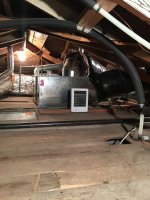rdavison39
New Member
Hi there - live in Toronto, Canada with some cold winters - not sure what the attic temp gets to exactly. I want to put in a rain shower head coming directly from above - but this would require running the copper up the wall and along the top of the shower in the attic (probably about 20" of copper in all in the attic). Question - would it be sufficent to insulate the pipe and perhaps build a box out of wall board to surround the pipe or should i stay away from this and just have a 90 degree pipe coming out of the wall. Obviously the wall option is safer but i've heard other contractors saying with insulation, a box and the attic insulation over the box it won't freeze - and even if it did - its not a "live" line....
Thoughts?
Thx
Ron
Thoughts?
Thx
Ron

